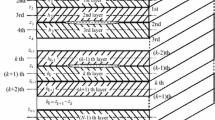Summary
Solid- and shell-type finite elements available for plasticity and creep analysis are applied to the creep-damage prediction of a thinwalled pipe bend under uniform internal pressure. Conventional creep-damage material model with scalar damage parameter is used. Based on the comparative numerical study, performed using solid and shell elements, the applicability frame of the shell concept is discussed. Particularly, if a dependence on the stress state is included in the material model, the cross-section assumptions of the first-order shear deformation theory should be refined. The possibilities to modify the through-thickness approximations are demonstrated on the beam equations. The first-order shear-deformation beam theory is discussed in detail. It is shown that if the damage evolution significantly differs for tensile and compressive stresses, the classical parabolic transverse shear-stress distribution and the shear-correction coefficient have to be modified within time-step simulations.
Similar content being viewed by others
Author information
Authors and Affiliations
Additional information
Received 30 January 2000; accepted for publication 30 May 2000
Rights and permissions
About this article
Cite this article
Altenbach, H., Kushnevsky, V. & Naumenko, K. On the use of solid- and shell-type finite elements in creep-damage predictions of thinwalled structures. Archive of Applied Mechanics 71, 164–181 (2001). https://doi.org/10.1007/s004190000132
Issue Date:
DOI: https://doi.org/10.1007/s004190000132




